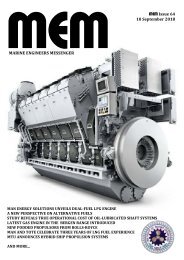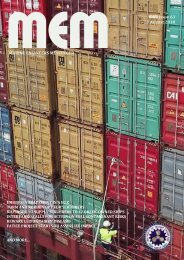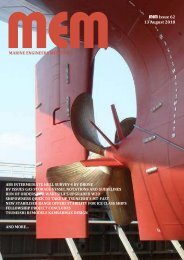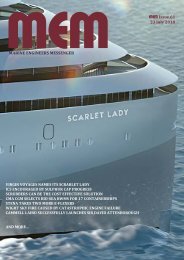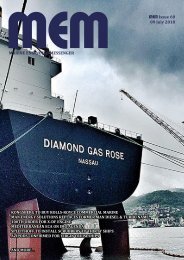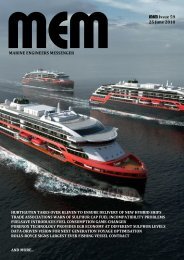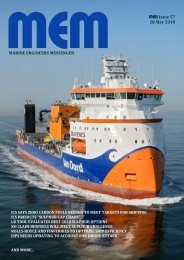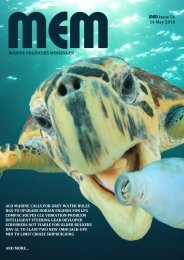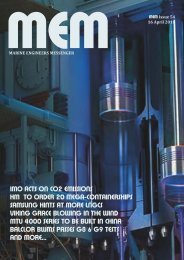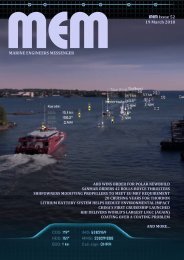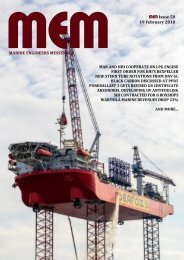Create successful ePaper yourself
Turn your PDF publications into a flip-book with our unique Google optimized e-Paper software.
defined in the charter-party, while<br />
also considering weather factors. If<br />
deviations occur, an automatic<br />
warning function will alert the<br />
performance manager or<br />
superintendent to initiate<br />
corrective action to prevent<br />
unnecessarily high fuel<br />
consumption and potential speed<br />
claims.<br />
As part of the tendering process,<br />
the Charter Monitor can be used as<br />
an information exchange platform<br />
between the ship manager and<br />
charterer for ship particulars that<br />
contain accumulated performance<br />
data from running ship operations.<br />
Simple user management controls<br />
access for efficient collaboration<br />
between the inspection and<br />
chartering department of the ship<br />
owner as well as with the<br />
charterer.<br />
Monitoring the impact of sailing<br />
practices on fuel consumption<br />
during a voyage is a key way to<br />
save fuel for ships that have been<br />
chartered, particularly on a voyage<br />
basis. This is the case for bulk<br />
carriers and tanker vessels. Based<br />
on a defined voyage distance and<br />
arrival time, the Bluetracker<br />
Voyage Monitor module documents<br />
a vessel’s operations on the basis of<br />
either constant speed, power or<br />
rpm.<br />
The Voyage Monitor accounts<br />
for reported and sensor-driven<br />
ship data as well as weather<br />
factors. All data is automatically<br />
checked to determine their<br />
plausibility, consistency and<br />
completeness. A traffic-light system<br />
shows whether a ship is sailing<br />
within the voyage-specific<br />
tolerance corridor and is thus<br />
operating in an energy-efficient<br />
manner. If for instance, the ship’s<br />
estimated time of arrival changes,<br />
the corridor can be recalibrated<br />
during the voyage.<br />
Performance managers and<br />
superintendents can configure<br />
voyage KPIs for analytical purposes<br />
and monitor the fuel-saving voyage<br />
practices.<br />
“The industry needs a reliable,<br />
measurable foundation from a<br />
fleet’s data pool in order to<br />
produce automated evaluations<br />
with clear KPIs,” Rey-Herme said.<br />
“The comparability of data in terms<br />
of energy efficiency and emission<br />
compliance is a fundamental<br />
requirement – both for time<br />
charters and voyage charters.”<br />
The latest software upgrade of<br />
Bluetracker One, Navis’s fleet<br />
performance management<br />
platform, also includes<br />
enhancements to the benchmark<br />
module and the Energy Efficiency<br />
Operational Indicator (EEOI)<br />
module. The benchmark module<br />
enables all ships to be compared<br />
and ranked on the basis of an<br />
individual score. This score is<br />
drawn from cumulative<br />
measurements of various<br />
performance criteria during a<br />
specific period of time. The EEOI<br />
module generates monthly EEOI<br />
reports for each ship. The EEOI<br />
scores of ships are ranked in<br />
accordance with specific company<br />
and ship-class greenhouse gas<br />
criteria.<br />
NEWBUILDS & DELIVERIES<br />
FIRST SAYARINGO STAGE TYPE LNGC LAUNCHED<br />
Mitsubishi Shipbuilding has held the christening<br />
ceremony for a next-generation liquefied natural gas<br />
carrier building for a Mitsubishi Corporation and NYK<br />
Line joint venture.<br />
Diamond Gas Orchid, the first Sayaringo STaGE type<br />
vessel, is designed to achieve significant improvements<br />
in both LNG carrying capacity and fuel performance<br />
due to a more efficient hull form and an innovative<br />
hybrid propulsion system.<br />
After completion in late June, the LNGC will go into<br />
service transporting LNG for the Cameron LNG Project,<br />
a project in the U.S. state of Louisiana in which<br />
Mitsubishi Corporation and NYK Line are jointly<br />
participating.<br />
The Sayaringo STaGE succeeds the Sayaendo, a<br />
vessel highly acclaimed for its improved Moss-type<br />
spherical tanks. The adoption of apple-shaped tanks in<br />
the new Sayaringo STaGE however is said to enable an<br />
increase in LNG carrying capacity without changing the<br />
ship's beam, while incorporation of a hybrid<br />
propulsion system has significantly boosted fuel<br />
efficiency compared to the Sayaendo.<br />
With a 73,800dwt, and the total holding capacity of<br />
the vessel’s tanks is 165,000m3.<br />
STaGE, an acronym deriving from Steam Turbine<br />
and Gas Engines, is a hybrid propulsion system<br />
combining a steam turbine and engines that can be<br />
fired by gas. Efficient use of the engines' waste heat in<br />
the steam turbine results in substantial improvement<br />
in plant efficiency, enabling high-efficiency navigation<br />
throughout a full range of speeds.<br />
17




